Friday, September 13, 2019 – Edinburgh, Scotland
Written by Jim
After leaving the town of Bamburgh on Thursday, we pointed our Scout northward towards Scotland. Rolling across the Scottish border, we immediately noticed an improvement in the quality of the roads over those in England. Our destination for that night was Prestopans, just east of the City of Edinburgh. Our campground was conveniently located near the bus line into the city, which allowed us to leave the motorhome parked at our pitch on Friday.
The next morning, we made our way to the bus stop.
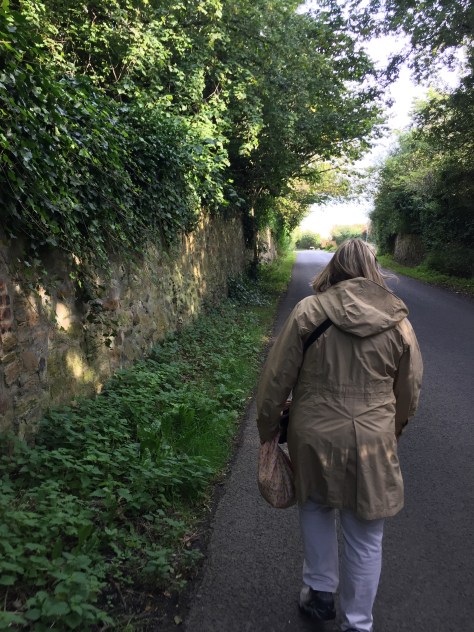
This is the two-way road we had to traverse to get to that point. When we planned the trip earlier this year, we were concerned about this narrow stretch after viewing it on Google Maps. It turned out to be a nice stroll, with only a few cars passing us while we made our way along. Like in York, they use immaculately clean double-decker buses.
Edinburgh (pronounced EDdin-buh-ruh) is Scotland’s second largest city and is its capital. It’s a combination of some very old buildings and plenty of new ones. Tower cranes dominate the skyline as the city continues to grow.

We disembarked the bus just below the Royal Mile at the Scott Monument. This is a memorial to the Scottish author, Sir Walter Scott. It was completed in 1844 and, despite needing a good cleaning, looks pretty good for its age!
Heading up towards Edinburgh Castle, we passed Princes Street Gardens.

Interestingly enough, this expanse of green lawn and trees was once a lake known as Nor Loch…or North Lake. It was a man-made medieval moat of sorts to act as a defense towards the north side of the old town. Problem was, sewage flowed downhill, so the lake became more of a stinking cesspool. It was eventually drained and cleaned up, making a lovely park that vegetation grows exceptionally well in. 😉
Once on the Royal Mile, we headed straight up the hill to the western end to see Edinburgh Castle.
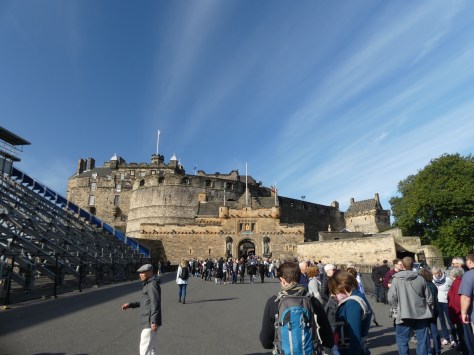
This massive stone structure sits high on a hill that overlooks the entire city. It is a very defendable location, to say the least. There has been a castle on this perch since the 12th century, and it is where the Crown Jewels of Scotland are displayed. Unfortunately, no photos were allowed of them, or of the Stone of Scone. If you’ve never heard of the latter, it is what Scottish kings and queens used to be coronated upon. England’s King Edward I took it to Westminster Abbey after the 1296 Battle of Dunbar. Since then, the kings and queens of Great Britain have been coronated upon it. British Prime Minister John Major returned it to Scotland in 1996, with the agreement that it be returned to Westminster for use during future British coronations. It’s a big, rectangular slab of rock that fits in a compartment underneath the coronation chair. A very important piece of rock, indeed.
Not much else impressed us on the interior of the castle, as most of the displays were modern. The exterior had some excellent firepower displayed though.
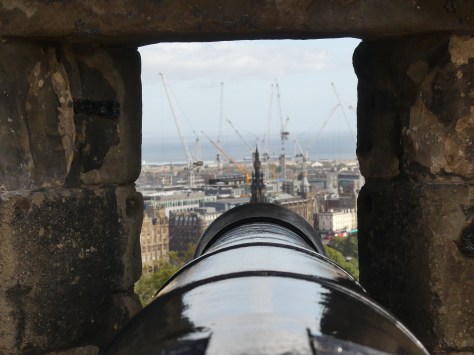
This large cannon had the Scott Monument in its crosshairs. Some of the many tower cranes we spoke of earlier can be seen in the photo.
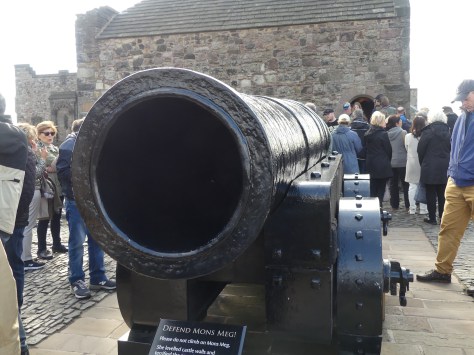
And check out this bemouth! This gun is known as Mons Meg, the world’s first weapon of mass destruction. The 20″ barrel can deliver a 386 pound cannonball a distance of over 2 miles. It was manufactured in the 1400’s.
From the castle, we headed down the Royal Mile towards St Giles Cathedral.

There were shops of all sorts lining the street. People from all over the world were out enjoying the nice weather.

St, Giles has a complicated history. It started out a Roman Catholic church, and was the center of the Scottish Reformation in the mid 1500’s. It was here that John Knox preached, and this became known as the birthplace of Presbyterianism. He was buried in the churchyard, which was destroyed in the mid 1600’s. The location of his grave is unknown.
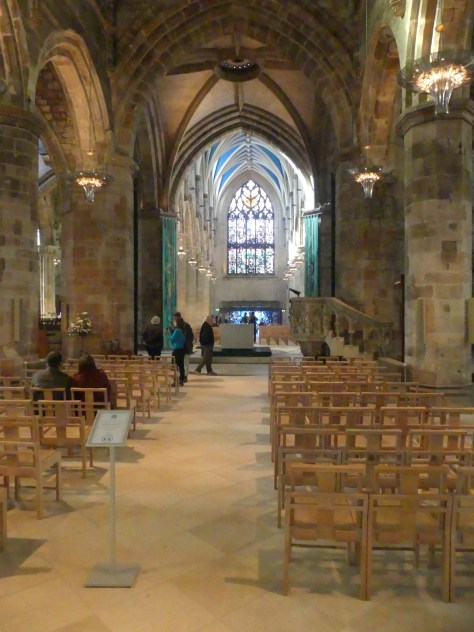
The interior was surprisingly light and airy, unlike the dark exterior. There were times that this space was partitioned into four separate churches, but it was restored to one large cathedral in the mid 1800’s.
An interesting side chapel we entered is home to The Order of the Thistle.
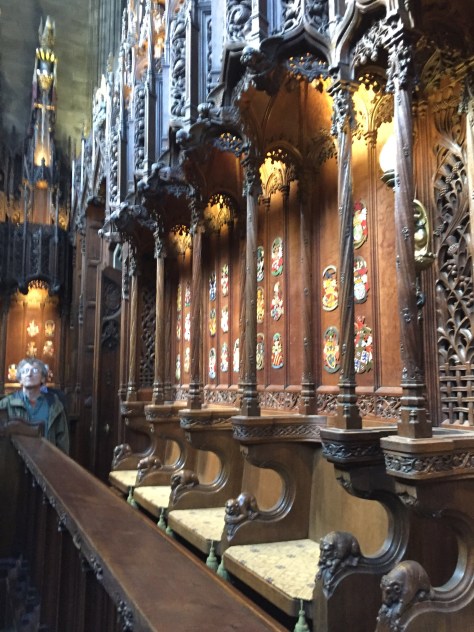
The thistle is the national flower of Scotland. The order is a collection of knights and ladies, selected by the monarch. The stall plates on the back of each stall serve as a record of the knights and ladies who have resided there.
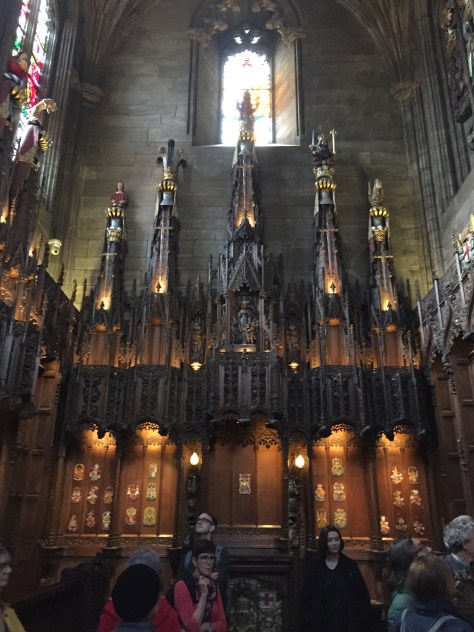
That person is currently Queen Elizabeth II, who presides over a meeting of the order each summer. Her seat is in the middle of this wall.
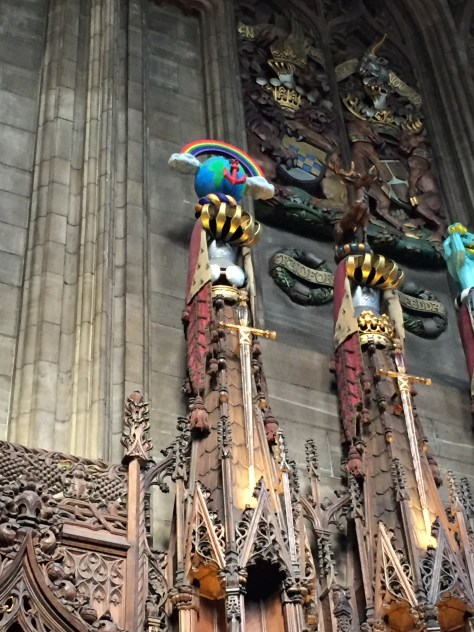
The top of each member’s stall is decorated with adornments of their choosing. When a knight or lady dies, the adornments are replaced with ones from the new member. We found the one on the left interesting, in that it was so modern looking. The rainbow and the anchor are meant to represent hope.
We really enjoyed our visit to Edinburgh. Next up, we move further north into the Scottish Highlands, into some of the most beautiful places we have ever seen. Diana has deep roots there, so you will definitely want to stay tuned for that. Until then, safe and happy travels to all!

Enjoyed this post so much. I love Edinburgh! Loved the Royal Mile, the castle and St. Giles Cathedral. Looking forward to your next posts. I have deep roots around Aberdeen. Am interested to hear about Diana’s.
LikeLiked by 1 person
We didn’t make it to Aberdeen this time, but Scotland is a definite for us to return to, Beth. We totally fell in love with it.
LikeLiked by 1 person
Love following your travels. So much fun!
LikeLiked by 1 person
Just think of how much powder would be required to send a 386 cannon ball 2 miles! Very cool.
LikeLiked by 1 person
Imagine how the earth shook when it hit, Jim!
LikeLike
Thanks for the tour, very interesting.
LikeLiked by 1 person
You’re welcome, Frank!
LikeLike
I was just thinking to myself, “Wow, that park is so lush and green!” and then you explained why, LOL! The outsides of the castles and churches are so somber, but the interior of that church is so light and bright. Such a contrast!
LikeLiked by 1 person
WoW! Love the architecture and history.
LikeLiked by 1 person
Interesting place, Gaelyn!
LikeLike
Still can’t believe you guys are in Scotland! Sounds like you’re comfortable with finding your way around and I’m loving all the history. Surprising to see all the construction cranes but I suppose it shouldn’t be, it’s 2019 there too 🙂 The church interior is stunning.
LikeLiked by 1 person
It’s really been a breeze navigating these countries, but the roads certainly require nerves of steel in a motorhome. On most two lanes, my mirrors are hanging over the lines on both sides. Tight curves, sheep in the road, narrow bridges…you get the picture. But it is all worth it, Jodee!
LikeLike
Thanks for sharing the photos and the history, Very interesting!
LikeLiked by 1 person
You’re welcome, Pam!
LikeLike